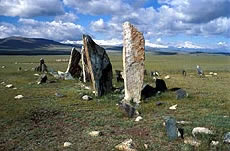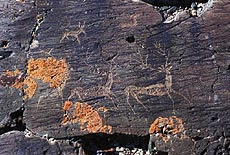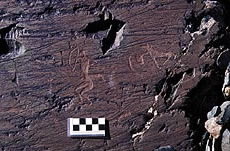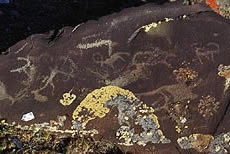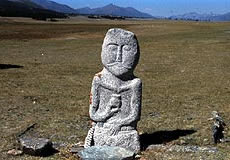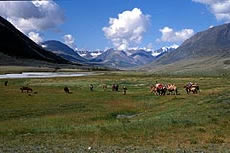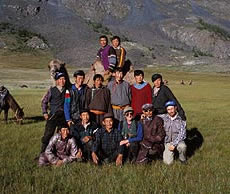Art History / Esther Jacobson-Tepfer Personal Web Page
Esther Jacobson-Tepfer, Kerns Professor
|
| Elk: detail from a hunting scene. Petroglyph from Tsagaan Gol, Bayan Ölgiy aimag, Mongolia. Photo: Gary Tepfer. | Archer and tethered horse: detail from a hunting scene. Petroglyph from Tsagaan Gol, Bayan Ölgiy aimag, Mongolia. Photo: Gary Tepfer. | Archer shooting at elk and wild bull. Petroglyph from Tsagaan Salaa III, Bayan Ölgiy aimag, Mongolia. Photo: Gary Tepfer. |
Since 1989, Jacobson-Tepfer’s research has been located in the Altay Mountains of North Asia. Since 1994, she has been collaborating with Mongolian and Russian colleagues on a project located in the Mongolian Altay and focussed on understanding the cultural ecology of the ancient Altay region. For more information on this project, please see http://darkwing.uoregon.edu/~altay/.
Dr. Jacobson-Tepfer is a past recipient of the Ersted Award for Distinguished Teaching. She was the first director of the University’s Center for Asian and Pacific Studies and Director of the NEH-funded project, Integration of Asian Materials into the University of Oregon's Humanities Program.
For the last several years, Dr. Jacobson-Tepfer has been on the board of the Mongolia Society and a member of the Editorial Board of the journal, Archaeology, Ethnology, and Anthropology of Eurasia (Novosibirsk, Russia). In 2002, Dr. Jacobson-Tepfer was awarded an honorary doctorate from the Institute of Archaeology, Mongolian Academy of Sciences, Mongolia. She holds the department’s Maude I. Kerns Professorship in Oriental Art.
Current research publication projects include her study (with colleagues) of two Mongolian petroglyphic sites, Aral Tolgoi and Tsagaan Gol. She is also working on a book on the art of rock art.
|
|
|
-
1993. The Deer-Goddess of Ancient Siberia: A Study in the Ecology of Belief ( Leiden: E. J. Brill.
-
1995. The Art of the Scythians: The Interpenetration of Cultures at the Edge of the Hellenic World. Leiden: E. J. Brill.
-
1996 (with V. D. Kubarev). Répertoire des Pétroglyphes d’Asie centrale. Sibérie du Sud 3: Kalbak-Tash I (République de l'Altai) . Tome V.3. Mémoires de la Mission Archéologique Française en Asie centrale Paris: De Boccard.
-
2001 (with V. D. Kubarev and D. Tseveendorj). Mongolie du Nord-Ouest: Tsagaan Salaa/Baga Oigor. Répertoire des Pétroglyphes d’Asie centrale, Fascicule no. 6. Jakov A. Sher and Henri-Paul Francfort, editors. 2 vols. Paris: De Boccard.
III. Recent articles devoted to petroglyphs include the following:
- “Approaches to the Study of Petroglyphs of North and Central Asia,’ with Henri-Paul Francfort. Forthcoming in Archaeology, Ethnology, and Anthropology of Eurasia
- “Petroglyphs and the Qualification of Bronze Age Mortuary Archaeology,” Archaeology, Ethnology, and Anthropology of Eurasia, 3 (11) 2002: 32–47.
- “Le plus ancient art à l’air libre en Mongolie-Altaï: images et paléoécologie,” pp. 209-216, in L’Art Paléolithique À L’Air Libre, ed. By Dominique Sacchi. Carcassonne: Gaep & Géopré, 2002.
- “Shamans, Shamanism, and Anthropomorphizing Imagery in Prehistoric Rock Art of the Mongolian Altay,” in: Henri-Paul Francfort and Roberte N. Hamayon, eds, in collaboration with Paul Bahn, Shamanism. Uses and Abuses of a Concept, (Bibliotheca Shamanistica, vol. 10), Budapest, Akadémiai Kiadó, 2002.
- “’Emblem’ Against ‘Narrative’ in Rock Art of the Mongolian Altay,” Bulletin of the Siberian Association of Prehistoric Rock Art Researchers, Vol. 3 (2000): 6-14 (in Russian and English).
- “Petroglyphs and Natural History: Sources for the Reconstruction of the Ecology of Culture.” Archaeology, Ethnology, and Anthropology of Eurasia Vol. 1 (2000): 57-65.
- "Early Nomadic Sources for Scythian Art," in: Ellen D. Reeder, ed., Scythian Gold: Trasures from Ancient Ukraine. Harry N. Abrams, in association with The Walters Art Gallery and the San Antonio Museum of Art: 59-69. New York, 1999.
- “The Recreation of Landscape Settings in Petroglyphs of Northern Central Asia (and reflections, again, on the sources of Chinese landscape representation], ”International Journal of Central Asian Studies (Seoul), Vol. 3 (1998): 192-214.
